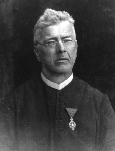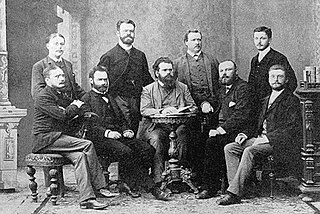
Graz is the capital city of Styria and second-largest city in Austria after Vienna. As of 1 January 2019, it had a population of 328,276. In 2015, the population of the Graz larger urban zone (LUZ) stood at 633,168, based on principal-residence status. Graz has a long tradition as a seat of higher education. It has four colleges and four universities with more than 60,000 students. Its historic centre (Altstadt) is one of the best-preserved city centres in Central Europe.

Gabriel Strobl was an Austrian Roman Catholic priest and entomologist who specialised in Diptera.
Fritz Schachermeyr was an Austrian historian, professor at the University of Vienna from 1952 until retirement.

Heinrich Streintz was an Austrian physicist.

Hohenwang is a ruined castle in Municipality of Langenwang, Styria, Austria. It stands on a hill at an elevation of 650 metres above sea level.

The Ore Mountain passes are crossings and passages over the crest of the Ore Mountains in Central Europe, over which tracks, roads, railway lines and pipelines run from the Free State of Saxony in the Federal Republic of Germany to Bohemia in the Czech Republic and vice versa.
Gustava Kahler, née Aigner, was an Austrian geologist and palaeontologist. She was noted in particular for her work with Franz Heritsch and with her husband, Franz Kahler. In recognition of her discovery of graptolites in the northern greywacke zone, her former fellow student, Ida Peltzmann, named two species for her.
Roderich Mojsisovics von Mojsvár was an Austrian composer based in Graz, head of the Schule des Musikvereins für Steiermark there.

Turicum was a Gallo-Roman settlement at the lower end of Lake Zurich, and precursor of the city of Zürich. Situated within the Roman province of Gallia Belgica and near the border to the province of Raetia, there was a tax-collecting point for goods traffic on the waterway Walensee–Obersee-Zürichsee–Limmat–Aare–Rhine.
Heinrich Appelt was an Austrian historian.

Manfred Ferdinand Buchroithner is an Austrian cartographer, developer of autostereoscopic cartographic visualisations, geologist, mountain researcher and mountaineer.
Franz Heritsch was an Austrian geologist and paleontologist, known for his studies of the Paleozoic of the Eastern Alps.
The Styria municipal structural reform was a local government reform in the Austrian state of Styria, which was made effective January 1, 2015. This reform nearly halved the number of Styrian municipalities as the reduced from 542 to 287. The reform was intended to reduce costs and ease election of new town officials. The terms of the reform is formalized in the Styrian Municipality Structural Reform Act. (StGsrG). The law was adopted on December 17, 2013 by the Landtag of Styria, and promulgated on April 2, 2014.

Raaba-Grambach is a market town in the district Graz-Umgebung in Styria, Austria since 2015. It was created as part of the Steiermärkische Gemeindestrukturreform of Styria at the end of 2014, dissolving the towns Raaba and Grambach. One complaint from both communities against merging was raised at the Constitutional Court but ended unsuccessfully.

Dirk Kaftan is a German opera and concert conductor.

The Graz Highlands or Graz Mountains are a low mountain range north of the Styrian state capital of Graz in Austria. It is part of the Central Alps and forms the start of the Prealps East of the Mur. From a geological perspective, regions on the west bank of the Mur, which are clearly separate from the building of the Styrian Prealps, belong to the Graz Highlands.
Phaeobalia dimidiata is a species of dance flies, in the fly family Empididae.
Harald Schmied was the Head of Communication & Fundraising of the Caritas Steiermark and was the founder - together with Mel Young - of the Homeless World Cup. He was married, had two sons and lived in Graz, Austria.
Rudolf Bülck was a German librarian.
Wolfgang Suppan was an Austrian musicologist. He is the father of the wind musician and composer Armin Suppan.
















